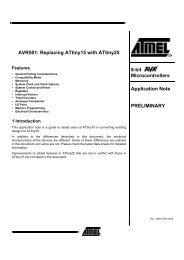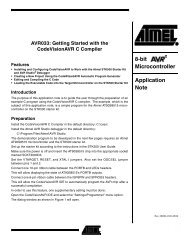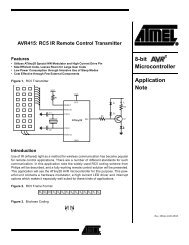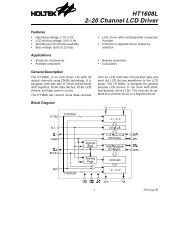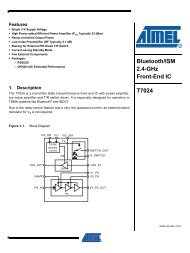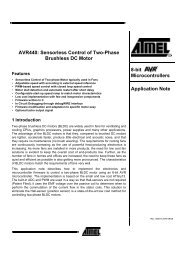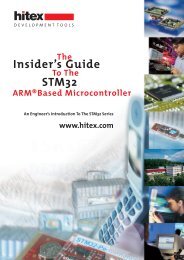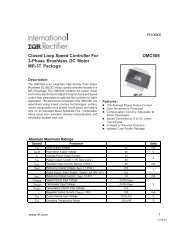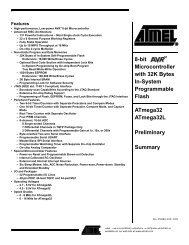64-megabit 2.7-volt Only Dual-interface DataFlash AT45DB642
64-megabit 2.7-volt Only Dual-interface DataFlash AT45DB642
64-megabit 2.7-volt Only Dual-interface DataFlash AT45DB642
- No tags were found...
Create successful ePaper yourself
Turn your PDF publications into a flip-book with our unique Google optimized e-Paper software.
AT45DB<strong>64</strong>2As with the Continuous Array Read, the CS pin must remain low during the loading of theopcode, the address bytes, the don't care bytes, and the reading of data. During a Burst ArrayRead with Synchronous Delay, when the end of a page in main memory is reached (the last bitor the last byte of the page has been clocked out), the system must send an additional 32don't care clock cycles before the first bit (or byte if using the parallel <strong>interface</strong> mode) of thenext page can be read out. These 32 don't care clock cycles are necessary to allow the deviceenough time to cross over the burst read boundary (the crossover from the end of one page tothe beginning of the next page). By utilizing the 32 don't care clock cycles, the system doesnot need to delay the SCK/CLK signal to the device which allows synchronous operation whenreading multiple pages of the memory array. Please see the detailed read timing waveformsfor illustrations (beginning on page 21) on which clock cycle data will actually begin to beoutput.When the last bit (or byte in the parallel <strong>interface</strong> mode) in the main memory array has beenread, the device will continue reading back at the beginning of the first page of memory. Thetransition from the last bit (or byte when using the parallel <strong>interface</strong>) of the array back to thebeginning of the array is also considered a burst read boundary. Therefore, the system mustsend 32 don't care clock cycles before the first bit (or byte if using the parallel <strong>interface</strong> mode)of the memory array can be read.A low-to-high transition on the CS pin will terminate the read operation and tri-state the outputpins (SO or I/O7-I/O0). The maximum SCK/CLK frequency allowable for the Burst Array Readwith Synchronous Delay is defined by the f BARSD specification. The Burst Array Read with SynchronousDelay bypasses both data buffers and leaves the contents of the buffers unchanged.MAIN MEMORY PAGE READ: A main memory page read allows the user to read datadirectly from any one of the 8192 pages in the main memory, bypassing both of the data buffersand leaving the contents of the buffers unchanged. To start a page read, an opcode of 52Hor D2H must be clocked into the device followed by three address bytes (which comprise the24-bit page and byte address sequence) and a series of don’t care bytes (four don’t carebytesif using the serial <strong>interface</strong> or 60 don’t care bytes if the using parallel <strong>interface</strong>). The first 13bits (PA12 - PA0) of the 24-bit (three-byte) address sequence specify the page in main memoryto be read, and the last 11 bits (BA10 - BA0) of the 24-bit address sequence specify thestarting byte address within that page. The four or 60 don’t care bytes that follow the threeaddress bytes are sent to initialize the read operation. Following the don’t carebytes,additionalpulses on SCK/CLK result in data being output on either the SO (serial output) pin or theparallel output pins (I/O7 - I/O0). The CS pin must remain low during the loading of theopcode, the address bytes, the don’t care bytes, and the reading of data. When the end of apage in main memory is reached, the device will continue reading back at the beginning of thesame page. A low-to-high transition on the CS pin will terminate the read operation and tristatethe output pins (SO or I/O7 - I/O0).BUFFER READ: Data can be read from either one of the two buffers, using different opcodesto specify which buffer to read from. An opcode of 54H or D4H is used to read data from buffer1, and an opcode of 56H or D6H is used to read data from buffer 2. To perform a buffer read,the opcode must be clocked into the device followed by three address bytes comprised of 13don’t care bits and 11 buffer address bits (BFA10 - BFA0). Following the three address bytes,an additional don’t care byte must be clocked in to initialize the read operation. Since thebuffer size is 1056 bytes, 11 buffer address bits are required to specify the first byte of data tobe read from the buffer. The CS pin must remain low during the loading of the opcode, theaddress bytes, the don’t care bytes, and the reading of data. When the end of a buffer isreached, the device will continue reading back at the beginning of the buffer. A low-to-hightransition on the CS pin will terminate the read operation and tri-state the output pins (SO orI/O7 - I/O0).1638F–DFLSH–09/025



